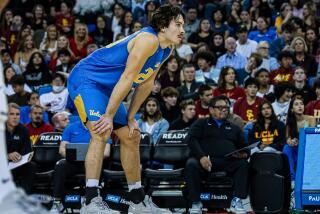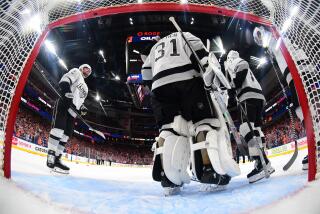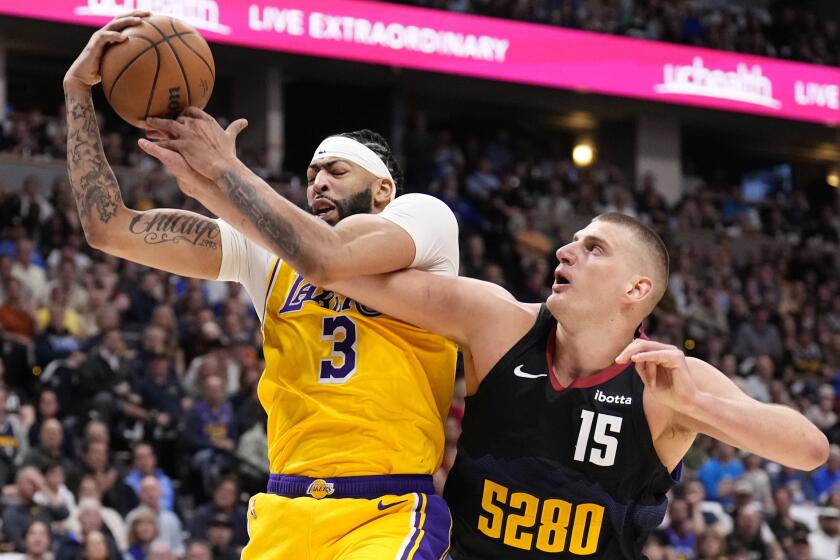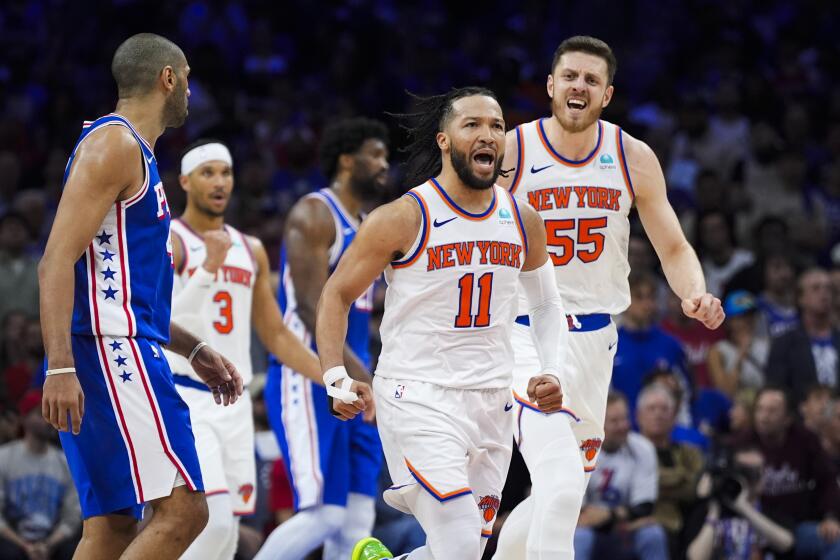NFL DRAFT ANALYSIS : Jacksonville Manages to Build Solid Base
Break up the Jaguars.
OK, that’s getting carried away. It still would be folly for Jacksonville fans to expect too much out of the Jaguars in their inaugural season. The Jaguars and Carolina Panthers still will be fortunate to win four games next season. Yet blessed with a bushel of bonus picks, the Jaguars did a remarkable job in their first draft -- and that also means the wise use of those choices to trade in and out of spots.
Among others, the Jaguars ended up with Southern California left tackle Tony Boselli, the top man on many draft boards throughout the league; second-round choice Brian DeMarco of Michigan State, slotted for the other tackle spot; and, shockingly, Boselli’s USC teammate and housemate, quarterback Rob Johnson in the fourth round.
Johnson was stubborn about holding the ball too long and taking unnecessary sacks behind the impenetrable Boselli and an overall strong line. But Johnson still was worthy of being taken much higher than the first pick on Sunday, and he drops into the Jaguars’ depth chart behind Steve Beuerlein, Mark Brunell and Andre Ware -- for now.
Once you toss in Tennessee running back James Stewart (No. 19 overall) and versatile Colorado defensive back/kick returner Chris Hudson (third round), it is clear that the Jaguars were astute.
“I want to grow with the team,” Boselli says. “I want to be here 10 years from now when we’re going to the Super Bowl and winning a lot of games and we’re one of the best teams in the league. I see no reason why that can’t happen.”
The word “guru” is one of the most overused words on draft issues, and most of the gurus outside the game are nothing but information gatherers and newsletter capitalists. Shame on the league for not hiring the equivalent of the NBA’s Marty Blake, who acts as a clearinghouse for basketball draft evaluations. But Gil Brandt, the former Dallas Cowboys’ personnel man and current consultant to several college all-star games and All-America teams, is the real thing.
“I think they knocked ‘em dead,” Brandt says. “They might have gotten their tackles for the next 10 years. Stewart’s a good back. Hudson’s a good player. Absolutely knocked ‘em dead.”
The rest of the league was envious, of course, that the expansion franchises received all those extra choices for their millions. Denver, for example, didn’t have a choice until the fourth round because of previous trades, leaving Broncos director of operations Bill Harpole to sit behind the helmet phone and read “The Chamber” before finally being able to write a name on a card 25 hours after Ki-Jana Carter went to the Cincinnati Bengals.
The Jaguars, though, didn’t botch the draft that will provide the foundation for seasons to come. If the “we-abstain” Cowboys, for example, had all those choices, they probably would have used the salary-cap excuse to trade down to obtain 23 seventh-round picks over the next five years. Nowhere was the Jaguars’ wisdom more obvious than at the tackle spot, where they acquired Boselli and DeMarco.
DeMarco, at 6 feet 5 1/2 and 314 pounds, isn’t a world beater, but he can be a solid starter at right tackle. Nothing spectacular. Solid. But that’s what you want in a right tackle, on the side opposite the key pass-blocking spot. “He’s another Jumbo Elliott,” Brandt says. DeMarco was the eighth tackle taken; he is better than that.
If expansion draft selection Eugene Chung, who came from the New England Patriots and Bill Parcells’ doghouse, can live up to his potential, the Jaguars already have the makings of a decent -- and maybe even better -- offensive line. For a first-year franchise, that’s incredible, even under the new expansion/free-agency rules of 1995.
It probably won’t be too long -- maybe a couple of seasons -- before Rob Johnson again is the starting quarterback, with Boselli protecting his blind side. Boselli is engaged to USC classmate Angie Aylor, who went to high school with Johnson, so Boselli and Johnson probably won’t be roommates again this fall in Jacksonville. But under the circumstances, it’s strange that they were selected by the same franchise. Johnson should have been the No. 3 quarterback taken, behind Steve McNair, who went third overall to the Houston Oilers; and Kerry Collins, taken at No. 5 overall by the Florida Panthers.
Instead, Todd Collins of Michigan (Buffalo Bills), Kordell Stewart of Colorado (Pittsburgh Steelers), Stoney Case of New Mexico (Arizona Cardinals) and Eric Zeier of Georgia (Cleveland Browns) all went before Johnson.
Again, any evaluation of draft success has to carry some disclaimers. Much of this depends on how many picks a team has, and where they are. Anyone who claims that this is some sort of exact science is bluffing -- and making the assumption you won’t remember their gaffes a year from now. But here are a few seat-of-the-press-section judgments.
--Bengals: They didn’t have to pay a very steep price to trade up from fifth to first and select Carter, easing the sting of their entirely justifiable decision to take Dan Wilkinson instead of Marshall Faulk with the No. 1 choice a year ago. Wilkinson has been a bust so far, but virtually everyone in the game agreed that he belonged on the top of the draft boards last season.
So now Carter gets to play within a 90-minute drive of his hometown of Columbus, Ohio -- or at least as long as the Bengals stay in Cincinnati.
--San Francisco 49ers: What do they need with J.J. Stokes, the UCLA wide receiver the Niners claimed after obtaining the No. 10 overall choice from the Browns? Check Jerry Rice’s and John Taylor’s birth certificates. And don’t be shocked if Taylor is somewhere else on opening day next fall. Stokes isn’t going to win an Olympic gold medal in the 100 meters, which teams discovered in the offseason workouts. But he’ll show that he is fast enough to make big plays and make everyone look silly who downgraded Stokes because of their continuing worship in the Cult Of The 40-Yard Dash.
--Indiapolis Colts: Bill Tobin’s revenge. Florida defensive tackle Ellis Johnson was a bargain at No. 15.
--St. Louis Rams: This is not a comment on defensive end Kevin Carter, who was a no-brainer pick at No. 6. But new Coach Rich Brooks, who was his own special teams coach at Oregon, got carried away with his affinity for the Pac-10 and the kicking game when he wasted a pick on University of Arizona kicker Steve McLaughlin in the third round. (G.M. Steve Ortmayer also is a former NFL special teams coach.) In the salary-cap age, it is folly to invest much in kickers -- no matter how good -- even if you are scheduled to play in a dome. If you sign a kicker in the third-round slotting game, you might not be able to afford to keep him long. Or if you do, you’re hurting yourself in the long run.
--New York Jets: No question, Kyle Brady is going to be a top tight end. But with Warren Sapp and Stokes still sitting there at No. 9, the Jets would have been better off to take one of them. Sapp would have been the best pick. In the wake of the Jets’ trade of Rob Moore to Arizona, selecting Stokes would have been understandable. Brady isn’t so good that the higher-priority needs should have been overlooked.
--Cowboys: Apparently trying to avoid the ignominy of drafting the sequel to Shante Carver, who still could turn out to be a decent pass rusher but was taken far too high last year, Jerry Jones and Co. did the expected.
They bailed out on the No. 28 pick, which the Tampa Bay Buccaneers acquired and used on Florida State linebacker Derrick Brooks. Brooks is undersized but worth a shot in the spot, no matter who had it. The 49ers have shown: Take the good players (however you can get them) and then worry about the cap.
--Philadelpia Eagles: When the entire league rushed to upgrade Boston College junior defensive end Mike Mamula after his combine workout, it made you want to pull out Kryptonite and check if he blanched. He did have 13 sacks for the Golden Eagles, and he might turn out to be great. But No. 7 overall?
After scouting these players on tape and in person for varying lengths of time, NFL teams in many cases continue to overreact to the offseason all-star games and combine-style workouts. Sometimes those evaluation opportunities are invaluable: such as when you are looking at players who worked in non-pro style offenses or played different positions or came from smaller programs. But it gets out of hand when the non-game scenarios seem to become more important than what the prospects did on the field. On Saturdays.
More to Read
Get our high school sports newsletter
Prep Rally is devoted to the SoCal high school sports experience, bringing you scores, stories and a behind-the-scenes look at what makes prep sports so popular.
You may occasionally receive promotional content from the Los Angeles Times.






